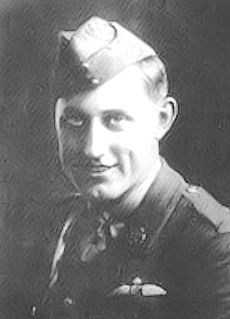
Andrew Frederick Weatherby (Anthony) Beauchamp-Proctor, was a South African airman and a recipient of the Victoria Cross, the highest award for gallantry in the face of the enemy that can be awarded to British and Commonwealth forces. He was South Africa's leading ace of the First World War, being credited with 54 aerial victories.

Arthur Treloar Whealy DSC & Bar DFC was a Canadian First World War flying ace, officially credited with 27 victories.
William McKenzie Thomson MC, DFC was a Canadian First World War flying ace, officially credited with 26 victories.
Stearne Tighe Edwards, was a Canadian flying ace of the First World War, officially credited with 17 victories. He was seriously injured in a crash the day after Armistice Day, and died from his injuries 10 days later.
James Alpheus Glen DSC & Bar was a Canadian First World War flying ace, officially credited with 15 victories.
Captain John Victor Sorsoleil MC was a Canadian First World War flying ace, officially credited with 14 victories.

Air Vice Marshal George Roberts Howsam, CB, MC was a Canadian First World War flying ace, officially credited with 13 victories.
Lieutenant Lionel Arthur Ashfield DFC was a World War I British flying ace credited with seven aerial victories.

Arthur Edmund Easterbrook was an American aviator who started his career as a World War I flying ace credited with five aerial victories. During World War II, he held several important positions in the U. S. Army Air Corps.
John Harry McNeaney was a Canadian First World War flying ace, flying with both the Royal Flying Corps and the Royal Air Force. He was credited with five aerial victories. John McNeaney was the only Canadian Sopwith Dolphin Ace.
Flight Lieutenant Edward Rochfort Grange was a World War I flying ace credited with five aerial victories. His postwar career included success as a businessman, and a return to aviation as a civilian inspector and auditor for the Royal Canadian Air Force during World War II.
Lieutenant Harold Arthur Sydney Molyneux was a World War I flying ace credited with five aerial victories. During World War II, he returned to service in the Royal Canadian Air Force.
Captain Ronald Sykes (1899-1977) was a World War I flying ace credited with six aerial victories.
Captain Horace Dale Barton was a World War I flying ace credited with 19 aerial victories.

Captain Oren John Rose, usually referred to as O. J. Rose was a World War I flying ace credited with 16 aerial victories.
Captain Charles William Cudemore was a World War I flying ace credited with 15 aerial victories.
Captain Andrew Cameron Kiddie was a World War I flying ace credited with 15 aerial victories.
Group Captain Eustace Osborne Grenfell was an early flying ace of World War I. He was credited with eight victories. He went on to make a career of the Royal Air Force. He was instrumental in developing the integrated radar/ground control system that won the Battle of Britain.
Captain William Henry Hubbard DFC was a Canadian World War I flying ace credited with twelve aerial victories against enemy fighter planes despite spending a year and a half out of action. He was noted for his zeal in ground support missions, as well as his success against enemy fighters.
Lieutenant Harold Francis Stackard was a First World War British flying ace credited with fifteen aerial victories. In addition to serving as a pilot during the war, he was a Royal Air Force instructor.






